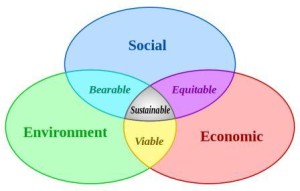Business Growth Through Environmental Sustainability
Business is growing incessantly day in and day out and has affected our lives like anything. We have gone mobile ending in our daily labor worth encapsulated in a micro chip. In the whole glitzy setup, most of us have gone purblind not reckoning the effect of growing money crunching machines on the environment where we dwell. The end result of such an imbalance is definitely alarming. This calls for an exigency where we need to set up a mutually compatible relationship with environment which apparently is possible through sustainability.
Businesses can potentially cause damage to all areas of the environment. The common ones include:
(1) Damaging rainforests and woodlands through logging and agricultural clearing
(2) Polluting water resources causes depletion of aquatic animals
(3) Polluting the atmosphere through the burning of fossil fuels
(4) Damaging prime agricultural and cultivated land through the use of unsustainable farming practices
To name a few instances in recent times such as the Chinese’s Giant Livestock farm which affected public health badly mostly because of stored manure of pigs, chickens etc. Thousands of dead pigs floating past Shanghai owes to growing polluting atmosphere which is no more congenial for living being’s survival. Studies have specified that about 8–9% of the total disease burden may be attributed to pollution, but considerably more in developing countries. Hence the vicious cycle goes around wherein man creates business which kills him altogether. Report for the UN into the activities of the world’s 3,000 biggest companies estimates one-third of profits would be lost if firms were forced to pay for use, loss and damage of environment. (Report by guardian).This figure is really shaking and scary.
As a positive move in this path, environment sustainability has shown keen enhancements in order to curb the evil affects of growing stuff without considering its effects on our counterpart.
Environmental sustainability forces businesses to look beyond making short term gains and look at the long term impact they do have on the natural world. For example, when manufacturing a product, the environmental impact of the product’s entire lifecycle, from development to disposal is seen and validated before finalizing designs.
 Good environment leads to business grooming in a most healthy and profitable way. It reduces risk, lowers costs, improves productivity and enhances reputation. Companies that are adopting these forward-looking practices are accruing benefits now. Alcoa has found that its sustainability track record gives it better access to large markets such as Brazil, where a positive environmental track record is becoming a more important component in selecting products .Companies that integrate the environment into their business decisions and reduce their environmental risk and potential liabilities are in a better position to secure investment and reduce their financial and reputational market exposure. Brebbia and Pineda (2004) claim that financial savings are one of the most significant factors that influence the implementation of environmental initiatives in a hotel. Green programs can provide a competitive advantage to leaders as long as green activities continue to be voluntary. Over time, however, green practices in the industry will become a baseline requirement, particularly as the cost of non-renewable energy continues to increase, regulatory pressure increases, and consumers become more demanding. Over the past 25 years, there has been a shift in the expectations and demands of consumers. Customers are more concerned about environmental issues such as recycling bottles, cans and paper at home as well as making greener lifestyle choices, such as organic food or fuel-efficient vehicles. Considerable examples show that profit can be aligned with environmental sustainability.
Good environment leads to business grooming in a most healthy and profitable way. It reduces risk, lowers costs, improves productivity and enhances reputation. Companies that are adopting these forward-looking practices are accruing benefits now. Alcoa has found that its sustainability track record gives it better access to large markets such as Brazil, where a positive environmental track record is becoming a more important component in selecting products .Companies that integrate the environment into their business decisions and reduce their environmental risk and potential liabilities are in a better position to secure investment and reduce their financial and reputational market exposure. Brebbia and Pineda (2004) claim that financial savings are one of the most significant factors that influence the implementation of environmental initiatives in a hotel. Green programs can provide a competitive advantage to leaders as long as green activities continue to be voluntary. Over time, however, green practices in the industry will become a baseline requirement, particularly as the cost of non-renewable energy continues to increase, regulatory pressure increases, and consumers become more demanding. Over the past 25 years, there has been a shift in the expectations and demands of consumers. Customers are more concerned about environmental issues such as recycling bottles, cans and paper at home as well as making greener lifestyle choices, such as organic food or fuel-efficient vehicles. Considerable examples show that profit can be aligned with environmental sustainability.
There are many initiatives in this direction taken by many companies and subsequently the world leaders are aligning by these so as to inflate growth and visibility. The famous CDP is directed towards the same mission following the concrete vision of sustainable development. It works with market forces to motivate companies to disclose their impacts on the environment and natural resources and take action to reduce them. CDP now holds the largest collection globally of primary climate change, water and forest-risk information and puts these insights at the heart of strategic business, investment and policy decisions. These initiatives play crucial role in encouraging companies to take the first steps in that measurement and management path.
However, if we fail to act now and environmental sustainability becomes more heavily regulated by governments, there could be significant costs involved. For example, regulators may begin charging businesses based on their negative impact on the environment, leaving you to play catch up and incurring expenses in the process. There may also be incentives and reward schemes introduced that will benefit businesses that operate at better than the minimum standards in relation to environmental sustainability, providing businesses that are sustainable with a clear advantage. Reference: Tony Hall, founding Director of GreenBizCheck, available at tonyhall.com.au)
There may be few key barriers that prevent companies from truly integrating sustainability considerations into their long-term strategies. Countless companies across the world struggle with these obstacles, such as: capital budgeting processes that fail to account for sustainability initiatives’ benefits; financial teams whose goals don’t align with those of the sustainability teams; and uncertainty about how to implement metrics that properly account for external environmental costs.
To align each goal so as the end result is sustainability the companies should set goals that integrate environmental considerations into core business decision-making. Also the sustainability team should be engaged early in project planning so as to reckon all the pros and cons with respect to the environment. Mainstreaming the best practices—and innovating new ones—can help put the world on a trajectory for a truly environmentally sustainable economy.
Author’s Bio:
 Essay is written by Ms.Priyanka Sawhney. She can be reached at priyanka2552[at]gmail.com.
Essay is written by Ms.Priyanka Sawhney. She can be reached at priyanka2552[at]gmail.com.
Do you have a flair for writing? Interested in environmental issues? Why don’t you submit an article for the GreenCleanGuide 2013 contest? For contest rules, please visit this link.



